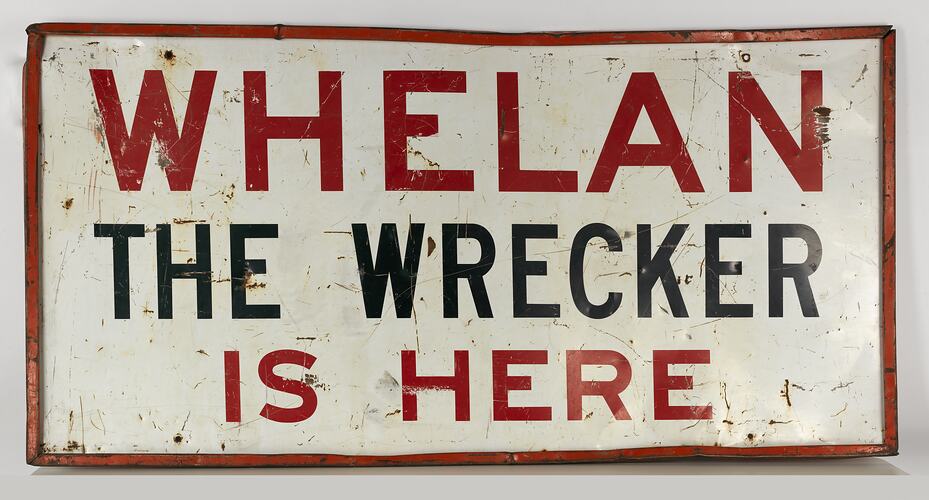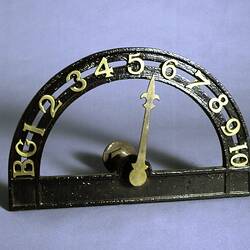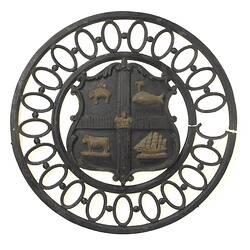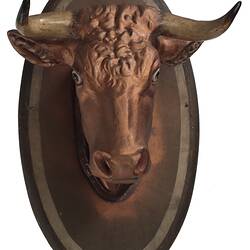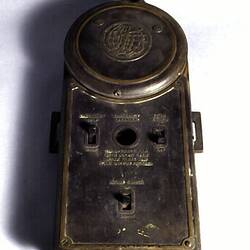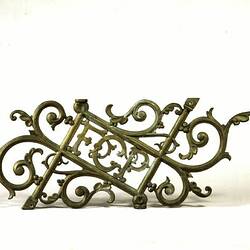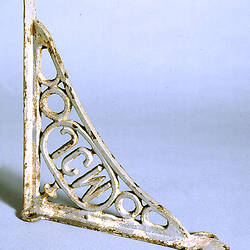This collection comprises about 178 objects donated to Museums Victoria by Myles Whelan in 1991. Consisting of bricks, industrial safety signs and posters, demolition equipment and relics from various demolished buildings, the collection came from Whelan the Wrecker, once Melbourne's most famous demolition company. Founded by James Whelan in 1892, the company began as a carting business, carrying goods of all sorts around Melbourne, before demolition and resale of the secondhand materials from demolished buildings became its main trade. The company's modern name, 'Whelan the Wrecker', was only adopted in 1938, though it had been known informally by the name for decades before then. After three generations of family ownership the company went into receivership and ceased trading during the 1991 recession.
Whelan the Wrecker became famous around Melbourne in part because of their slogan. Wherever they were demolishing buildings they put up a sign that read 'WHELAN THE WRECKER IS HERE'. This well known slogan made their part in the demise of many of Melbourne's older buildings quite clear. During the 1970s there were debates about the preservation of historic buildings, the building of freeways and the demolition of working class housing areas in cities across Australia. When these issues came up in Melbourne, sites where Whelan's were working became the centre of protests and legal wrangling. In the eyes of campaigners for historic preservation, such as the Victorian Heritage Trust, the demolishers were working for governments and developers who had no appreciation of the past. They cared not forthe beauty of long cherished landmarks neglected by their owners or the vibrant communities that had become their custodians, only for the profits that redevelopment offered. As a result, Whelans came to be regarded with contempt by many for their part in carrying out these acts of destruction.
Some of the objects in this collection point to another side of the Wrecker's approach to their work. As well as wrecking buildings and selling on the remains, the family and workers at Whelan's were also collectors. The collection held today by the Museum was initially gathered together by people who had a sense of the importance of the buildings that they were knocking down, or at least the attractiveness of some of their parts. The fact that objects like the Bull's head plaque from the Bull and Mouth Hotel, the custom made cast iron from the Federal Coffee Palace (later to be known as the Federal Hotel), and the Coat of Arms from Melbourne's Eastern Market were saved, show that sometimes there was more than just wrecking going on.
In addition to these pieces of famous buildings, the Whelan's collection has provided the Museum with an impressive selection of bricks from many of Melbourne's now vanished brickworks, in particular from the many brickworks that once fueled the great 19th century building boom of the 'Marvellous Melbourne'. The collection includes bricks from the Hoffman Brickworks, whose surviving re-purposed kilns are virtually the sole remnant of an industry that once dominated Brunswick. The collection also includes bricks made in Northcote, Oakleigh, Auburn, South Yarra and Box Hill.
The oldest bricks in the collection, however, were not made in Melbourne. This group of four bricks came from the Theatre Royal which once stood in Bourke Street, between Russell and Exhibition Streets. These hand-made bricks were donated to the Museum by the company's founder, Jim Whelan, when he oversaw the demolition of the theatre in 1933, to make room for Manton's department store. The Theatre was built in 1855, before any brick making businesses are known to have operated in Melbourne. Two of the bricks from the Theatre Royal were imported from Glasgow. The other two are thought to have come from a section of the Theatre that was rebuilt in 1874, after a fire. Jim Whelan said the bricks came from a South Yarra works, possibly from the first brickworks in the city, which was founded in 1866.
The collection also features nineteen occupational health and safety signs produced by the National Safety Council of Australia. Ranging from subjects such as the importance of workplace safety to specific safety issues such as 'Your back is not a crane' and 'Don't set booby traps'. This set of posters reflects the concerns of Myles Whelan, the last Managing Director of the company. As Robyn Annear noted, 'Since the '60s, Myles had been a driving force in the promotion - and legislation - of safe practices within an inherently dangerous industry.' (Annear, 2005, p.274)
The final part of the collection is the set of objects relating to the demolition trade. Warning lamps and signs, sledgehammers, Wrecker's picks with their one long point for digging in between rows of bricks, steel cap boots and a home-made box to hold detonators provide a connection to the work of knocking down buildings. This was a physical and demanding type of work, and the well-used tools remind us of the labour that went into extracting the architectural remnants - the bricks, ironwork and fittings - that make up the bulk of the collection.
The objects were collected by curators from Museums Victoria in 1991, in the very last days of Whelan the Wrecker. Staff recall a hot December day spent gathering a selection of objects from the yard on Sydney Road, following Myles Whelan's directions to find objects associated with significant buildings and locations amongst the general detritus that filled the yard.
These different aspects of the Whelan Collection all make valuable contributions to our knowledge of, and connections to, Melbourne's past. Whelan's work gangs and wrecking balls cleared space to let others reshape Melbourne's appearance for a century. Through their habit of putting special things to one side, we have some pieces of the older versions of the city in the Museum's collection today.
References:
Annear, Robyn (2005). A City Lost and Found: Whelan the Wrecker's Melbourne, Black Inc., Melbourne
Draper, Patricia (1997). 'One Man's Trash: the Whelan Collection and how it could be used within the framework of the Museum of Victoria, at Carlton Gardens'. Unpublished Masters Thesis, Deakin University.
Davison, Graeme, and McConville, Chris, (eds) (1991). A Heritage Handbook, Allen and Unwin, North Sydney.
Burgmann, Meredith and Burgmann, Verity (1998). Green Bans, Red Union: Environmental Activism and the New South Wales Builders Labourers' Association, UNSW Press, Sydney.
Yule, Peter (ed) (2004). Carlton: A History, Melbourne University Publishing, Carlton.
More Information
-
Keywords
buildings, structures & establishments, architectural feature, construction industry, building labourers, interior decoration, Cultures and histories : Melbourne and Victoria
-
Localities
-
Authors
-
Article types
